Uncannytober 2022 Illustrations
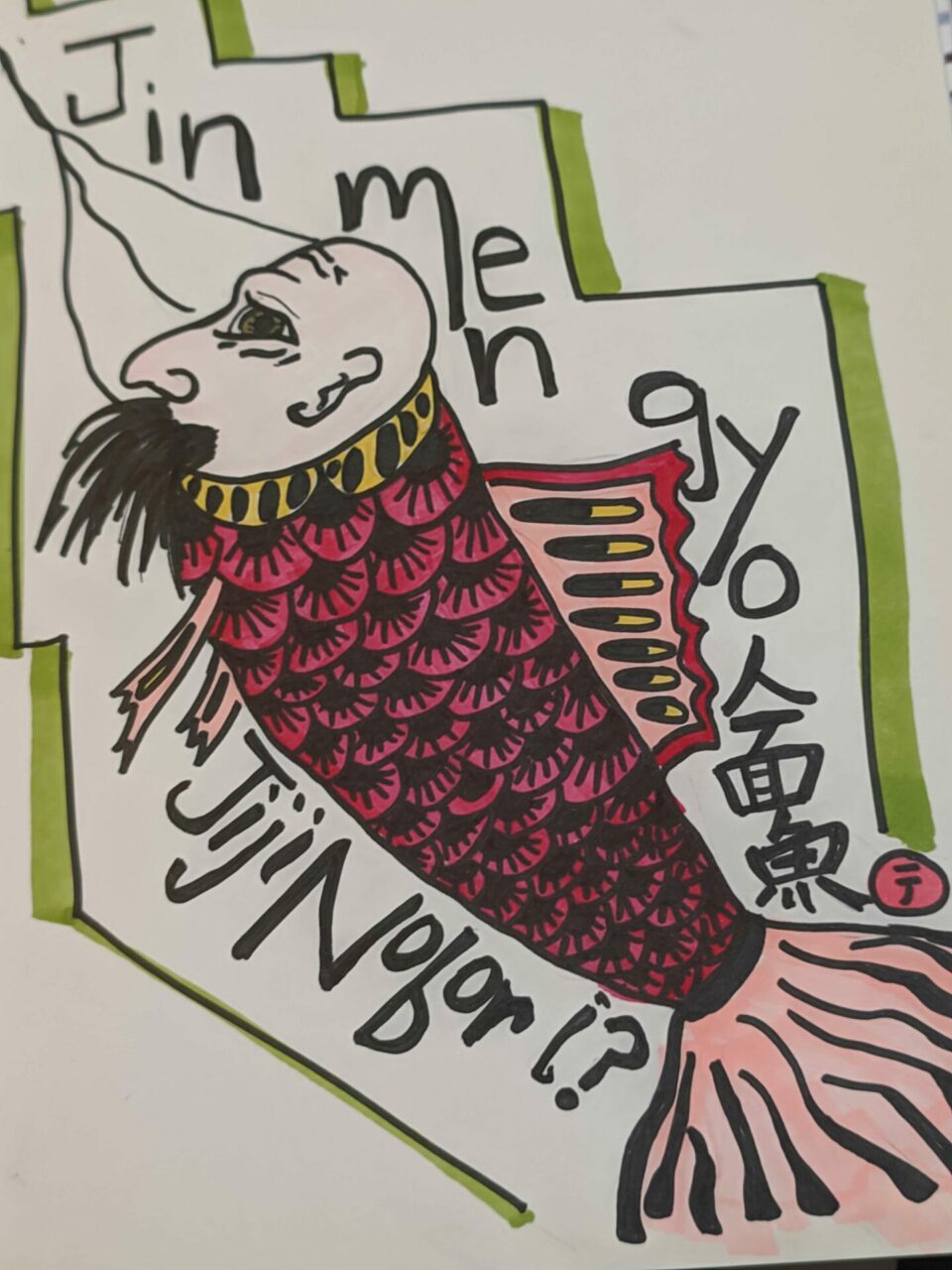
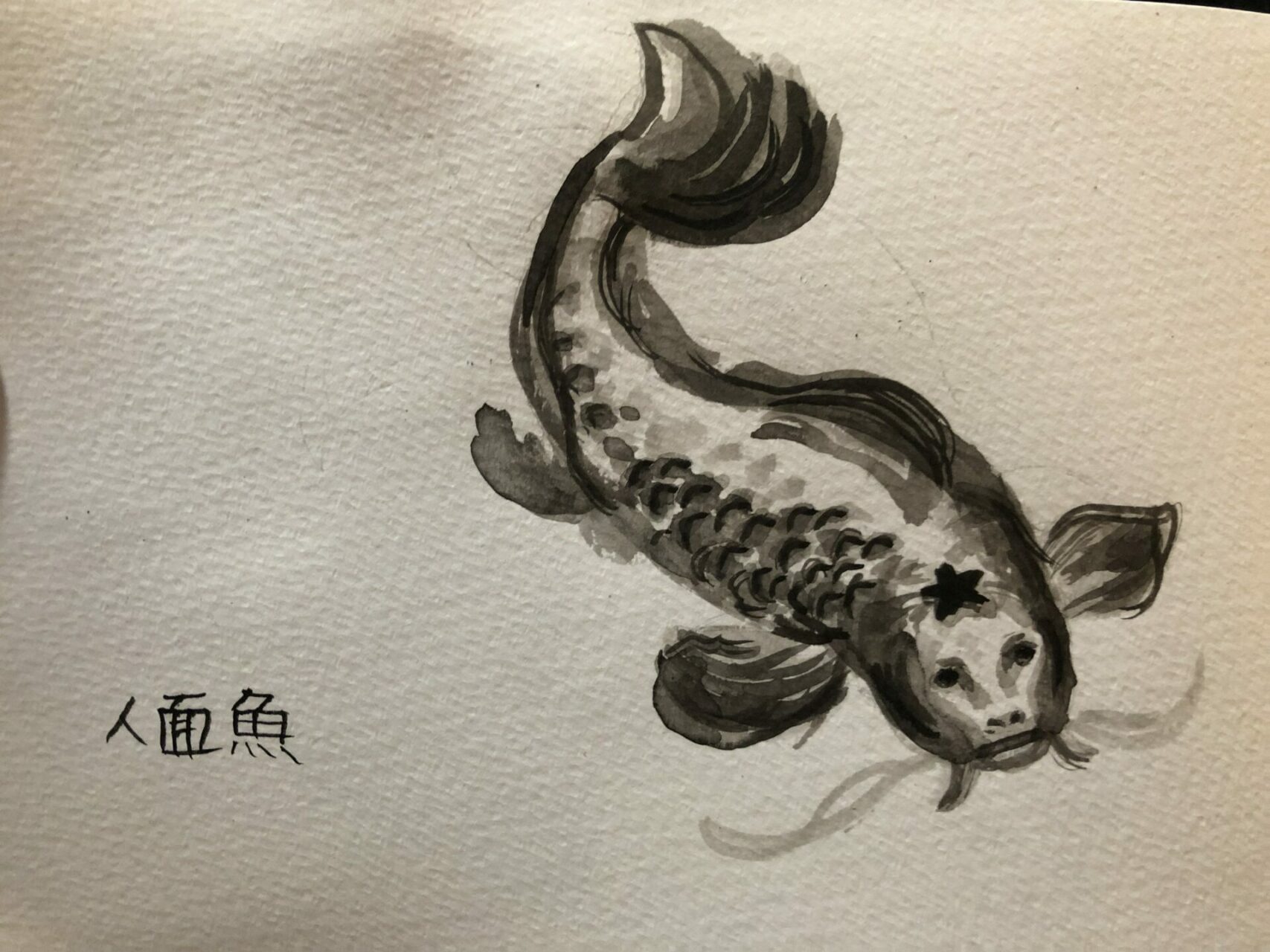
Next time you’re staring down into a rowdy school of koi, keep an eye out for the one that has a human face. This is a jinmengyo and rumor has it if you see one a tsunami is on its way.
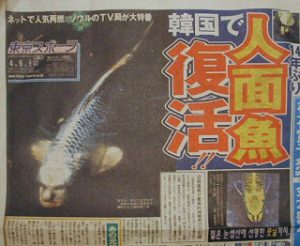
Newspaper reporting human-faced fish spotted in Korea after 14 years
Or maybe if you’re lucky, you’ll get a glimpse of the nekomengyo/cat-faced carp. Which is much cuter until it grows those long legs and walks around at night.
Uncanny Japan is author me, Thersa Matsuura, exploring all that is weird from Japan. Strange superstitions and old wives tales, cultural oddities and interesting language quirks. These are little treasures I dig up while doing research for my writing, and I want to share them with you here on Uncanny Japan. I hope you like the show.
Hey hey everyone, this is Uncanny Japan. It’s February and it’s my birthday, or it was my birthday last week sometime. In Japan, February 11th is a holiday, so everyone gets off, not to celebrate me, mind you, it’s actually kenkoku kinen no hi, or more excitingly, National Foundation Day; a day to commemorate the mythical beginnings of Japan when Jimmu became the very first emperor back in 660 BCE.
Emperor Jimmu
Speaking of long long ago, when I was in university, a Japanese exchange student was telling me about the very early history of Japan, and I thought he said the first emperor’s name was Emperor Jim, and I cracked up. Emperor Jim? Alas no, not Jim. His name is Jimmu, and the two characters that constitute the honorable Jimmu make up the coolest Japanese emperor’s name I’ve ever heard. 神 is the kanji for god, and 武 means warrior, military, or fierce. It’s the same mu in musha or musha-burui that I talked about on the very first Uncanny Japan two years ago. Musha means warrior, so Emperor Jimmu means “emperor god warrior.” He was also quite handsome if you are to believe the wood block depictions of him. Anyway, February 11th is also the day MacArthur approved the draft version of the Japanese constitution in 1946. So yeah, all in all it’s not a particularly interesting holiday here in Japan. People enjoy having the day off. Some put Japanese flags outside their homes or businesses, but otherwise I don’t see much that goes on.
What is a Jinmengyo?
Ok, on to today’s topic. If you’re not driving, walking your pup or otherwise in need of your vision, close your eyes and imagine you’re strolling through a Japanese garden. You’re on a narrow path of crushed gravel, meandering past moss-covered rocks and neatly trimmed trees. You pass an old ojizo statue wearing a dirty tattered red cap and bib. He smiles serenely as you continue to follow the downward sloping footpath until you reach the banks of a small jade-colored pond. You stop and look down. Your presence has invited dozens of brightly colored koi to the edge of the water. They crowd and roll over each other, sucking at the surface making big slurping noises with their cold fishy lips. They think you might have something delicious hidden in your pockets. You don’t however. So you just enjoy their silliness and their beautiful mottled colors. Gold, orange, black and white. And you’re almost feeling zen when you notice something strange about one of the fish. But before you can identify what it is that unnerved you, it’s lost again in the aquatic tussle. You think it was probably your imagination; your mind playing tricks on you and you’re just about to walk away when you see it again. This time there’s no mistaking. While the other fish continue to jostle each other for your attention, there is one fish, a little off to the side, and it’s looking right at you with the face of a man. Your blood turns cold in your veins because you have just been seen by a jinmengyo. The literal translation is a human-faced fish.
The way I learned about the jinmengyo was back when my son Julyan was in kindergarten. His best friend was a little girl who suddenly one day refused to walk to school. When pressed, we learned it was because under the little bridge we had to cross to get there was a river full of jinmengyos, or so she insisted. I remember soon after that feeding the koi with Julyan and us trying to spot one of these creepy creatures. I remember when we first saw one, too.
The Jinmengyo Origin Story
But let me back up a little bit. I really can’t figure out when the jinmengyo rumor first appeared in Japan, but back in 1990 the tabloid Friday published a photo sent in by a reader of a purported jinmengyo. And that caused quite the fuss. The picture was said to be taken in Yamagata Prefecture, Tsuruoka City, at a temple called Zempo-ji. People all over Japan went a little nuts, everyone trying to get a glimpse of their own human-faced fish.
The rumor eventually jumped the ocean and in 2015 jinmengyo were spotted in Korea and China as well. You can still find the tabloid pages online if you search around a bit. You might think the jinmengyo myth is 100% made up, but it’s not entirely. It’s based on this cool thing that happens to some carp. Their markings eerily resemble a human face–eyes, nose, sometimes a mustache or beard. When you’re looking down at a mess of koi and you spot one it is a tad disconcerting and it really does look like a human face looking up at you. I can understand why and my son’s friend was creeped out by all these men’s faces staring up at her.
Jinmengyo-related Superstition
There is also a superstition about the jinmengyo. It is said if one appears it means a tsunami is coming. This old wives tale is echoed in the Ghibli movie Ponyo. If you’ve seen the movie you know that Ponyo is a kind of jinmengyo herself. She’s got a fish body and a human head. I’ve seen the Japanese version, and in the scene and the retirement home with all the old people, one old woman says just this. If you see a jinmengyo, a tsunami is fixing to hit, which does happen in the movie. I haven’t seen the English language version but I’m guessing it says pretty much the same thing.
The Jinmengyo Video Game “Seaman”
Here’s another interesting thing I found that’s related to the jinmengyo. There’s a Japanese game called Seaman by Sega Dreamcast that came out way back in 1999. The whole premise of the game is that you raise your own virtual pet, a pet that happens to be a human-faced fish named Gillman. This is by no means an action game but it garnered a cult status and won some awards. What makes it different than your normal virtual pet type game is that you can talk to your fish and your fish can talk back to you. And when I say talk back to you, that’s what I mean. It said that is really rude but in the end he’s kind of endearing. When you hatch your fish Gillman, at first it just makes cute baby sounds. But after a few days of your attention and love, it begins to talk in this hoarse voice. It begins asking you questions like how old are you, when’s your birthday. Stuff like that. So you raise and care for your man-fish and it in turn keeps you company and will eventually grow legs and become this weird amphibious creature. You spend so much time and energy with this thing that the creator said in the end it’s not like you raised your seaman, but he raised you.
One reason I wanted to talk about this is I found something very sweet when I was reading around. One of the developers wrote in an Easter egg that she never, ever thought would be used. But one day one of the players of the game began talking about suicide to his fish. It was then that the human faced fish turned around looked him in the eye and responded. I can’t find out exactly what he said, but whatever it was the man went online later and said that the little seaman saved his life. I thought that was kind of sweet. I’ve never played the game but after reading about it I am intrigued. The English language version is even narrated by Leonard Nimoy, which is another plus.
Nekomengyo
Now, there isn’t only a human faced fish, a jinmengyo, but there’s also something not quite as popular but worth mentioning, called a nekomengyo, or cat-faced fish. This little story sprouted up also back in 1990 when everyone was out of their minds about the jinmengyo. It’s set in Gifu prefecture at a place called Ibuki Falls and the story goes like this.
Once upon a time, there was a very large cat that lived on Gongen Mountain. It was very big and scary and all the other animals were frightened of it. The cats favorite food was the koi that lived in the pond at the bottom of Ibuki Falls. The cat though was very big and very slow and couldn’t always catch the fish. He would have to wait until he was very hungry before he got desperate enough to snag one or two of the koi. One day the cat pleaded with the water god. “Water god, I wish I could eat enough of these koi to become very, very full. Please grant me this wish.” The water god was surprised at the request. The god thought and then answered. “OK, but if you wish to eat all the fish until your heart’s content, then you must be able to swim. Here, I will leave your face the way it is but I will give you a carp body.” The cat was pleased with this deal and immediately jumped into the water. Poof. And splash.
But something funny happened. Once the cat was in the water with its cat face and fish body, it realized it no longer had an appetite for fish. Soon it became friends with all the carp and to this day lives there peacefully in the little beautiful lake. That’s the sweet version but there is another urban myth that’s been going around that says at night, the cat-fish grows long legs and you can see it walking around the banks of the lake. I think that’s the one I’d rather see.
The Carp-Faced Boy
OK, so today I will end with a little bit of me trivia. The title story to my last collection, The Carp-Faced Boy, was me riffing on the idea of the jinmengyo. My thinking being, if you can have a human-faced carp, why not a carp faced human? Better yet a small child, whose creepy and grows and may or may not have it out for certain people, like his grandpa. Anyway, I love my little carp-faced boy invented character. It was because of him in that story that I was offered a deal for the entire collection, and from there I was told a freaky story about someone who every time she went out with her elderly father-in-law, would encounter a small child crying eerily nearby. Every time, almost as if on cue. So often in fact that they were beginning to get a little freaked out. It always sounded like the same child, too. After she read my story she was convinced it was a carp-faced boy. So I like to believe that he escaped the confines of the book and is now out there pestering people all around the world. If you ever see him, take a photo because I know a good magazine we can send it to and get a lot of attention.
Thank you all for listening. That’s all for today. I wish everyone well. All my love to my patrons. And I’ll talk to you soon. Bye bye.
Pssst! Hey, do you like scary stories? Or maybe you don’t do full-on horror, but enjoy a nice dark tale. Something creepy involving Japanese folklore and superstition. Well, if that’s the case, you can sneak on over to Amazon or wherever you like to buy books and look for my two short story collections: A Robe of Feathers and The Carp-Faced Boy. All you need to do is search for Theresa Matsuura. Let me spell that for you. T-H-E-R-S-A, M-A-T-S-U-U-R-A. Another place you can find me doing things is on Patreon. There, once a month for my five dollar and up patrons, I translate, retell and record obscure Japanese folktales. Some are dark, some are humorous, some are just weird. And lastly, another super sweet thing you can do is to write a review on iTunes. By doing this you help like minded people find Uncanny Japan. It’s a little thing but it means a lot and it’s a great big help. Thank you, I’m Thersa Matsuura, and I’ll talk to you soon.
Credits
Intro and outro music by Julyan Ray Matsuura

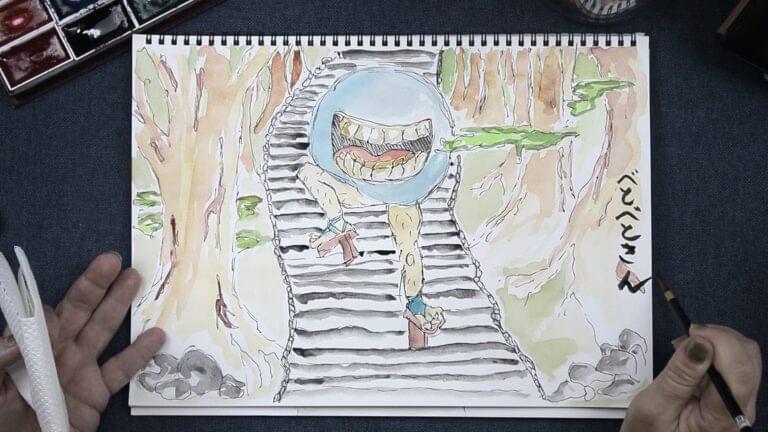
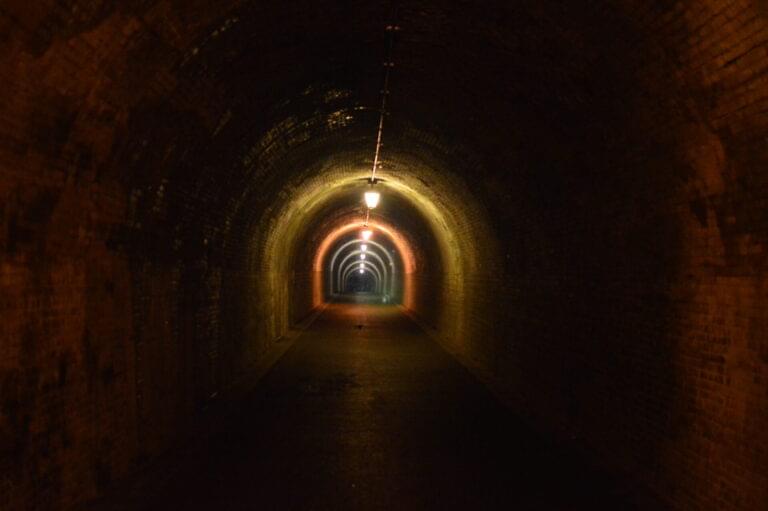
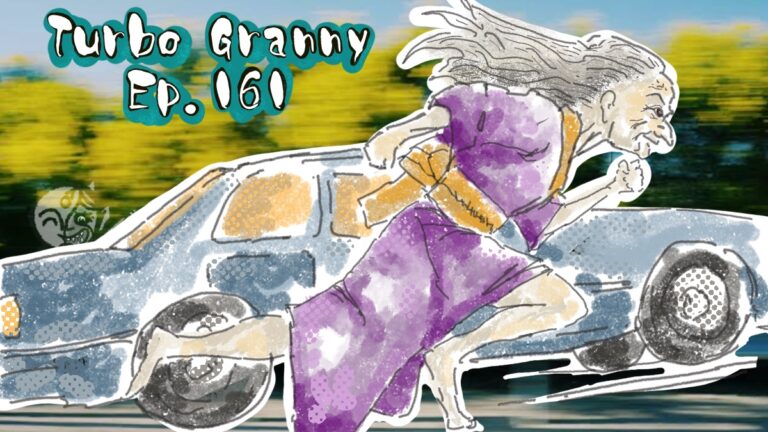
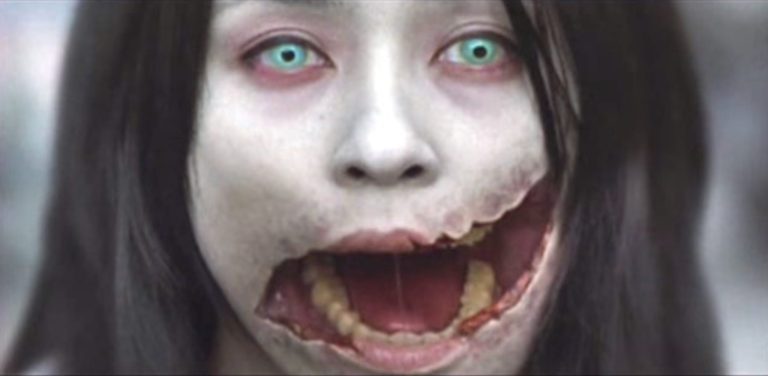


I remember the jinmengyo from Zelda Wind Waker game! Throw the food out and he talks to you about the ocean.